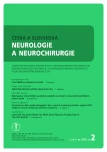Normal Pressure Hydrocephalus – Overdrainage Complications and their Dependence on the Used Valve
Authors:
V. Vybíhal 1
; G. Hanoun 1; Marek Sova 1
; M. Smrčka 1; Z. Bortlíček 2; M. Keřkovský 3
Authors‘ workplace:
Neurochirurgická klinika LF MU a FN Brno
1; Institut biostatistiky a analýz MU, Brno
2; Radiologická klinika LF MU a FN Brno
3
Published in:
Cesk Slov Neurol N 2013; 76/109(2): 217-220
Category:
Short Communication
Overview
Overdrainage is one of the complications of normal pressure hydrocephalus as well as of hydrocephalus in general. The authors of this paper compared the impact of fixed pressure valves and programmable valves with gravitational units or anti-siphon devices on the development of overdrainage. We analyzed a group of 82 patients recruited between 2003 and 2011 with the mean age of 66.8 years (median 67.2 years), 42 of which were implanted with fixed pressure valves and 40 were implanted with programmable valves. Overdrainage was identified in 8 (19.0%) of the 42 patients with fixed pressure valves. There was no need for surgical revision in the group of patients with the programmable valves, except for one patient who failed to attend a planned follow up visit and arrived 11 months later. Programmable valves with gravitational units or anti-siphon devices reduce significantly the incidence of complications from overdrainage. They contribute to improved results of surgical therapy in patients with normal pressure hydrocephalus and reduce the need for shunt revisions.
Key words:
normal pressure hydrocephalus – shunt
Sources
1. Meier U, Lemcke J. First clinical experiences in patients with idiopathic normal-pressure hydrocephalus with the adjustable gravity valve manufactured by Aesculap (proGAV(Aesculap)). Acta Neurochir Suppl 2006; 96: 368–372.
2. Goodwin CR, Kharkar S, Wang P, Pujari S, Rigamonti D, Williams MA. Evaluation and treatment of patients with suspected normal pressure hydrocephalus on long-term warfarin anticoagulation therapy. Neurosurgery 2007; 60(3): 497–501.
3. Hakim S. Hydraulic and mechanical mis-matching of valve shunts used in the treatment of hydrocephalus: the need for a servo-valve shunt. Dev Med Child Neurol 1973; 15(5): 646–653.
4. Zemack G, Romner B. Adjustable valves in normal--pressure hydrocephalus: a retrospective study of 218 patients. Neurosurgery 2002; 51(6): 1392–1400.
5. Boon AJ, Tans JT, Delwel EJ, Egeler-Peerdeman SM, Hanlo PW, Wurzer HA et al. Dutch Normal-Pressure Hydrocephalus Study: randomized comparison of low- and medium-pressure shunts. J Neurosurg 1998; 88(3): 490–495.
6. Raftopoulos C, Massager N, Balériaux D, Deleval J, Clarysse S, Brotchi J. Prospective analysis by computed tomography and long-term outcome of 23 adult patients with chronic idiopathic hydrocephalus. Neurosurgery 1996; 38(1): 51–59.
7. Han YM, Yoo DS, Kim DS, Huh PW, Cho KS, Kang JK. A clinical analysis of the ventriculoperitoneal shunt with programmable shunt device. J Korean Neurosurg Soc 1999; 28: 75–81.
8. Reinprecht A, Czech T, Dietrich W. Clinical experience with a new pressure-adjustable shunt valve. Acta Neurochir (Wien) 1995; 134(3–4): 119–124.
9. Turner DA, McGeachie RE. Normal pressure hydrocephalus and dementia – evaluation and treatment. Clin Geriatr Med 1988; 4(4): 815–830.
10. Tsuji O, Sato K. CSF dynamics in a patient with a programmable shunt. Acta Neurochir Suppl 1998; 71: 364–367.
11. Sindou M, Guyotat-Pelissou I, Chidiac A, Goutelle A. Transcutaneous pressure adjustable valve for the treatment of hydrocephalus and arachnoid cysts in adults. Experiences with 75 cases. Acta Neurochir (Wien) 1993; 121(3–4): 135–139.
12. Miyake H, Kajimoto Y, Tsuji M, Ukita T, Tucker A, Ohmura T. Development of a quick reference table for setting programmable pressure valves in patients with idiopathic normal pressure hydrocephalus. Neurol Med Chir (Tokyo) 2008; 48(10): 427–432.
13. Cobb WS, Burns JM, Kercher KW, Matthews BD, Norton JH, Heniford TB. Normal intraabdominal pressure in healthy adults. J Surg Res 2005; 129(2): 231–235.
14. Kajimoto Y, Ohta T, Miyake H, Matsukawa M, Ogawa D, Nagao K et al. Posture-related changes in the pressure environment of the ventriculoperitoneal shunt system. J Neurosurg 2000; 93(4): 614–617.
15. Kim KH, Yeo IS, Yi JS, Lee HJ, Yang JH, Lee IW. A pressure adjustment protocol for programmable valves. J Korean Neurosurg Soc 2009; 46(4): 370–377.
16. Meier U, Kiefer M, Neumann U, Lemcke J. On the optimal opening pressure of hydrostatic valves in cases of idiopathic normal-pressure hydrocephalus: a prospective randomized study with 123 patients. Acta Neurochir Suppl 2006; 96: 358–363.
17. Kaestner S, Kruschat T, Nitzsche N, Deinsberger W. Gravitational shunt units may cause under-drainage in bedridden patients. Acta Neurochir (Wien) 2009; 151(3): 217–221.
18. Meier U, Lemcke J. Is it possible to optimize treatment of patients with idiopathic normal pressure hydrocephalus by implanting an adjustable Medos Hakim valve in combination with a Miethke shunt assistant? Acta Neurochir Suppl 2006; 96: 381–385.
19. Lemcke J, Meier U, Müller C, Fritsch M, Kiefer M, Eymann R et al. On the method of a randomised comparison of programmable valves with and without gravitational units: the SVASONA study. Acta Neurochir Suppl 2012; 114: 243–246.
20. Lemcke J, Meier U, Müller C, Fritsch M, Eymann R, Kiefer M et al. Is it possible to minimize overdrainage complications with gravitational units in patients with idiopathic normal pressure hydrocephalus? Protocol of the randomized controlled SVASONA Trial (ISRCTN51046698). Acta Neurochir Suppl 2010; 106: 113–115.
Labels
Paediatric neurology Neurosurgery NeurologyArticle was published in
Czech and Slovak Neurology and Neurosurgery

2013 Issue 2
- Metamizole vs. Tramadol in Postoperative Analgesia
- Memantine in Dementia Therapy – Current Findings and Possible Future Applications
- Memantine Eases Daily Life for Patients and Caregivers
- Metamizole at a Glance and in Practice – Effective Non-Opioid Analgesic for All Ages
- Advances in the Treatment of Myasthenia Gravis on the Horizon
Most read in this issue
- Creutzfeldt-Jacob disease
- Spinocerebellar Ataxia 7 – a Case Report
- Lyme Borreliosis as a Cause of Bilateral Neuroretinitis with Pronounced Unilateral Stellate Maculopathy in a 8-Year Old Girl
- Electrophysiological Examination of the Pelvic Floor
